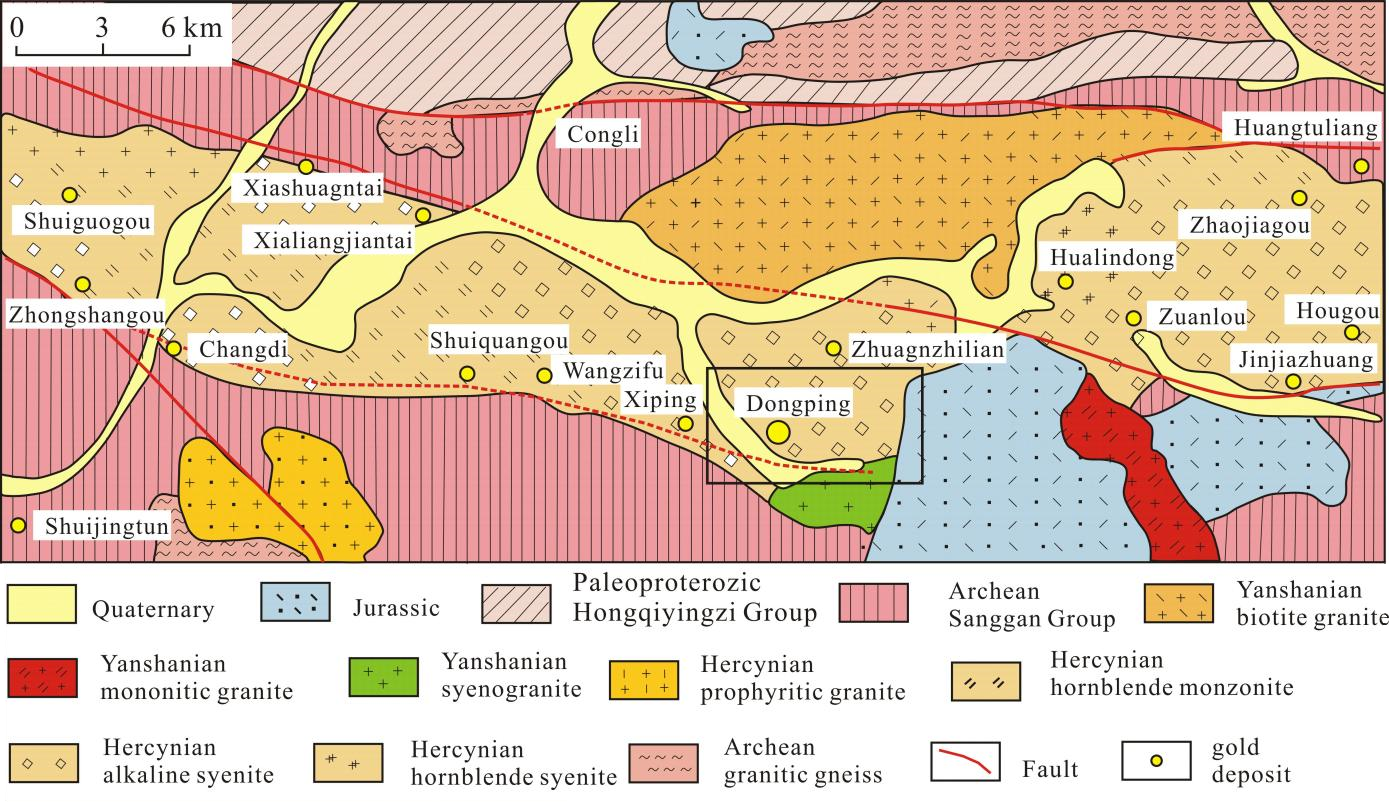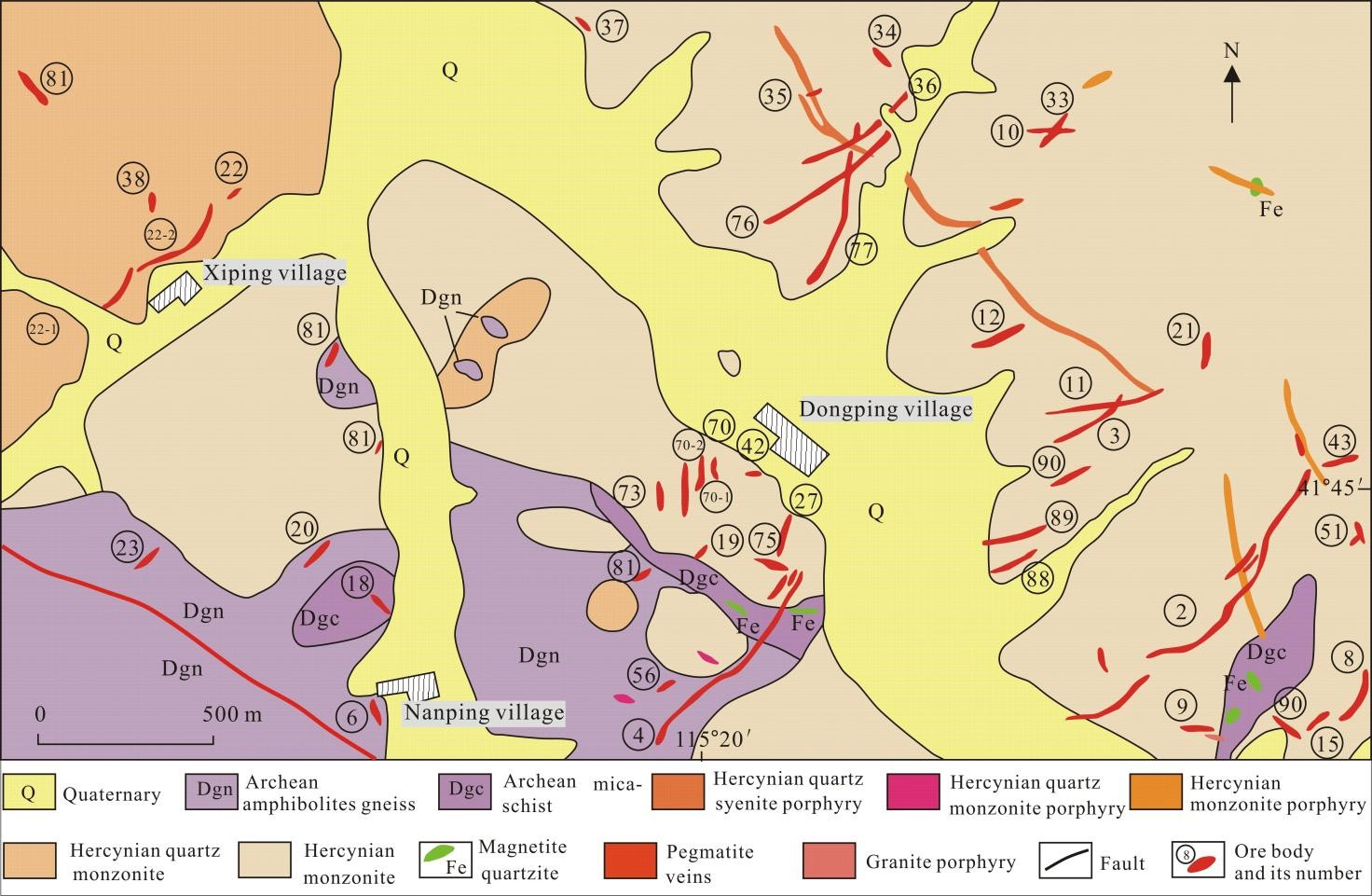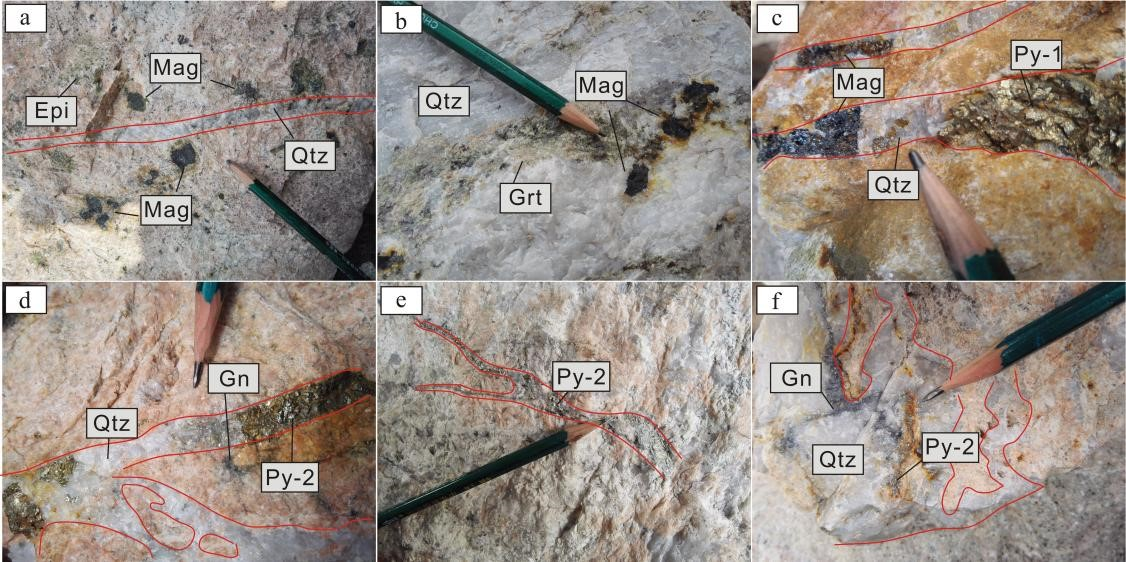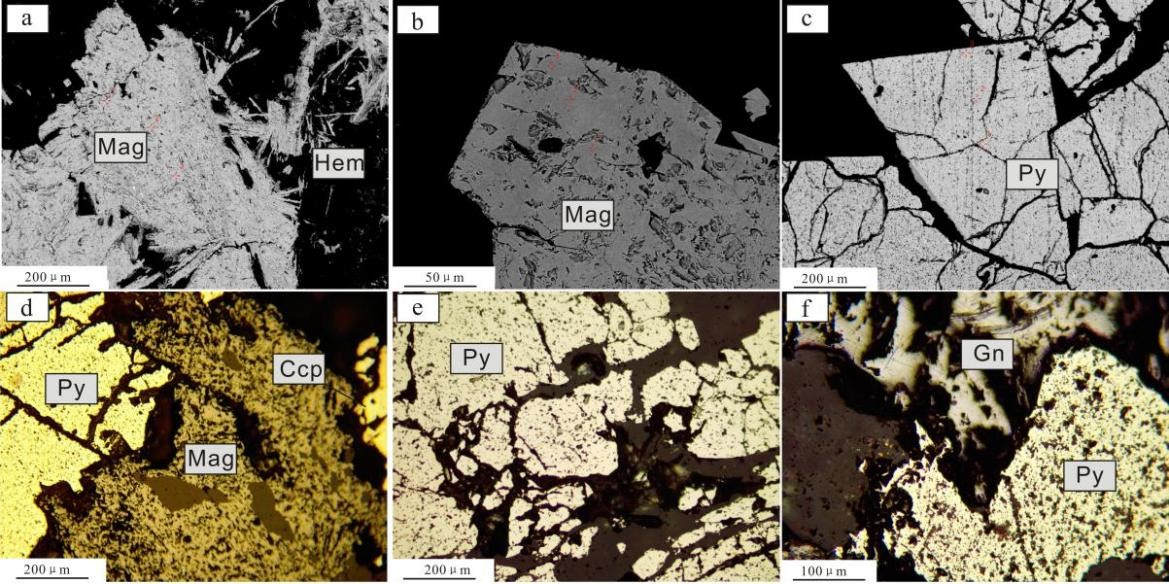Ore Genesis of the Dongping Gold Deposit in the Northern Margin of North China Craton: Constraints from In-Situ Major, Trace Elemental Analysis of Magnetite and Pyrite
Abstract
:1. Introduction
2. Regional and Ore District Geology
3. Ore Deposit Geology and Mineralization Characteristics
4. Samples and Analytical Methods
4.1. Sample Descriptions
4.2. Analytical Methods
5. Analytical Results
5.1. Magnetite
5.2. Pyrite
6. Discussion
6.1. Occurrences of Elements in Magnetite and Pyrite
6.2. Implications for the Mineral Genesis
6.2.1. Magnetite
6.2.2. Pyrite
6.3. Constraints on Hydrothermal Fluid Evolution
7. Conclusions
- Two magnetite sub-types, including disseminated magnetite in altered potassic igneous rocks and magnetite in quartz vein, and two pyrite sub-types, including pyrite in oxide-ore stage (Py-1), pyrite in gold-bearing sulfide-telluride-ore stage (Py-2), are identified in the Dongping deposit.
- A combined EMPA and LA-ICP-MS analysis on magnetite reveals that magnetite from Dongping have lower Ti and V contents, as well as wide ranges of Al, Mn, and Ca contents, indicating that they are originated from magmatic-hydrothermal fluids rather than igneous origins. These magnetites are interpreted to have resulted from low-temperature conditions of hydrothermal activity.
- The average Au contents of pyrites from Dongping are relatively lower. The time-resolved signals of LA-ICP-MS of pyrite indicates that Co and Ni enter pyrite lattice by forming solid solutions, whereas Pb, Zn, and Cu mainly present as sulfide inclusions. From Py-1 to Py-2, Co shows a decreasing trend, indicating that the temperature of ore forming fluids has decreased. Combined with previous research of fluid inclusion, we infer that the enrichment of metal elements in Py-2 is related to the cooling or boiling of the fluids.
Author Contributions
Funding
Acknowledgments
Conflicts of Interest
References
- Zhou, T.; Lü, G. Tectonics, granitoids and Mesozoic golddeposits in east Shandong, China. Ore Geol. Rev. 2000, 16, 71–90. [Google Scholar] [CrossRef]
- Zhou, T.; Goldfarb, R.J.; Phillips, G.N. Tectonic and distribution of gold deposits in China—An overview. Miner. Depos. 2002, 37, 249–282. [Google Scholar] [CrossRef]
- Yang, J.H.; Wu, F.Y.; Wilde, S.A. A review of the geodynamic setting of large-scale late mesozoic gold mineralization in the north china craton: An association with lithospheric thinning. Ore Geol. Rev. 2003, 23, 125–152. [Google Scholar] [CrossRef]
- Zhai, M.G.; Santosh, M. The early Precambrian odyssey of the North China Craton: A synoptic overview. Gondwana Res. 2011, 20, 6–25. [Google Scholar] [CrossRef]
- Zhao, G.C.; Sun, M.; Wilde, S.A.; Li, S.Z. Late Archean to Paleoproterozoic evolution of the North China Craton: Key issues revisited. Precambr. Res. 2005, 136, 177–202. [Google Scholar] [CrossRef]
- Mao, J.W.; Li, Y.Q.; Goldfarb, R.J.; He, Y.; Zaw, K. Fluid inclusion and noble gas studies of the Dongping gold deposit, Hebei Province, China: A mantle connection for mineralization? Econ. Geol. 2003, 98, 517–534. [Google Scholar] [CrossRef]
- Bao, Z.W.; Zhao, Z.H.; Zhang, P.H.; Wang, Y.X. Ree, Sr, Nd, and Pb isotopic evidence for the petrogenesis of the Shuiquangou syenite complex in nw hebei province. Geol. Rev. 2003, 49, 60-596. [Google Scholar]
- Wang, D.; Liu, J.; Zhai, D.; Carranza, E.; Wang, Y.; Zhen, S.; Wang, J.; Wang, J.; Liu, Z.; Zhang, F. Mineral paragenesis and ore-forming processes of the dongping gold deposit, hebei province, China. Resour. Geol. 2019, 69, 287–313. [Google Scholar] [CrossRef]
- Gao, S.; Xu, H.; Zhang, D.; Shao, H.; Quan, S. Ore petrography and chemistry of the tellurides from the dongping gold deposit, hebei province, China. Ore Geol. Rev. 2015, 64, 23–34. [Google Scholar] [CrossRef]
- Bao, Z.; Sun, W.; Li, C.; Zhao, Z. U–Pb dating of hydrothermal zircon from the dongping gold deposit in north china: Constraints on the mineralization processes. Ore Geol. Rev. 2014, 61, 107–119. [Google Scholar] [CrossRef]
- Bao, Z.W.; Li, C.J.; Zhao, Z.H. Metallogeny of the syenite-related Dongping gold deposit in the northern part of the North China Craton: A review and synthesis. Ore Geol. Rev. 2016, 73, 198–210. [Google Scholar] [CrossRef]
- Zhao, G.C.; Cawood, P.A.; Li, S.Z.; Wilde, S.A.; Sun, M.; Zhang, J.; He, Y.H.; Yin, C.Q. Amalgamation of the North China Craton: Key issues and discussion. Precambr. Res. 2012, 222–223, 55–76. [Google Scholar] [CrossRef] [Green Version]
- Deng, J.; Wang, Q.F. Gold mineralization in China: Metallogenic provinces, deposit types and tectonic framework. Gondwana Res. 2016, 36, 219–274. [Google Scholar] [CrossRef]
- He, C.S.; Santosh, M.; Yang, Q.Y. Gold metallogeny associated with craton destruction: A geophysical perspective from the North China Craton. Ore Geol. Rev. 2016, 75, 29–41. [Google Scholar] [CrossRef]
- Li, S.R.; Santosh, M. Geodynamics of heterogeneous gold mineralization in the North China Craton and its relationship to lithospheric destruction. Gondwana Res. 2017, 50, 267–292. [Google Scholar] [CrossRef]
- Nie, F.J. Type and distribution of gold deposits along the northern margin of the North China Craton, People’s Republic of China. Int. Geol. Rev. 1997, 39, 151–180. [Google Scholar] [CrossRef]
- Song, G.R.; Zhao, Z.H. Geology of Dongping Alkaline Complex-Hosted Gold Depositin Hebei Province; Seismological Press: Beijing, China, 1996; pp. 4–109, (In Chinese with English Abstract). [Google Scholar]
- Li, C.M.; Deng, J.F.; Su, S.G.; Li, H.M.; Liu, X.M. Two stage zircon U–Pb ages of the potash altered rock in the Dongping gold deposit, Hebei Province, and their geological implications. Acta Geosci. Sin. 2010, 31, 843–852, (In Chinese with English Abstract). [Google Scholar]
- Zhang, Z.C.; Mao, J.W. Geology and geochemistry of the Dongping gold telluride deposit, Heibei Province, North China. Internat. Geol. Rev. 1995, 37, 1094–1108. [Google Scholar]
- Cisse, M.; Lü, X.; Algeo, T.J.; Cao, X.; Li, H.; Wei, M.; Chen, M. Geochronology and geochemical characteristics of the Dongping ore-bearing granite, North China: Sources and implications for its tectonic setting. Ore Geol. Rev. 2017, 89, 1091–1106. [Google Scholar] [CrossRef]
- Gao, S.; Xu, H.; Li, S.; Santosh, M.; Zhang, D.; Yang, L.; Quan, S. Hydrothermal alteration and ore-forming fluids associated with gold-tellurium mineralization in the Dongping gold deposit, China. Ore Geol. Rev. 2017, 80, 166–184. [Google Scholar] [CrossRef]
- Hu, Z.C.; Zhang, W.; Liu, Y.S.; Gao, S.; Li, M.; Zong, K.Q.; Chen, H.H.; Hu, S.H. “Wave” Signal-Smoothing and Mercury-Removing Device for Laser Ablation Quadrupole and Multiple Collector ICPMS Analysis: Application to Lead Isotope Analysis. Anal. Chem. 2015, 87, 1152–1157. [Google Scholar] [CrossRef] [PubMed]
- Liu, Y.S.; Hu, Z.C.; Gao, S.; Günther, D.; Xu, J.; Gao, C.G.; Chen, H.H. In situ analysis of major and trace elements of anhydrous minerals by LA-ICP-MS without applying an internal standard. Chem. Geol. 2008, 257, 34–43. [Google Scholar] [CrossRef]
- Cook, N.J.; Ciobanu, C.L.; Mao, J.W. Textural control on gold distribution in Asfree pyrite from the Dongping, Huangtuliang and Hougou gold deposits, North China Craton (Hebei Province, China). Chem. Geol. 2009, 264, 101–121. [Google Scholar] [CrossRef]
- Nadoll, P.; Angerer, T.; Mauk, J.L.; French, D.; Walshe, J. The chemistry of hydrothermal magnetite: A review. Ore Geol. Rev. 2014, 61, 1–32. [Google Scholar] [CrossRef]
- Ciobanu, C.L.; Cook, N.J.; Utsunomiyas, S.; Kogagwa, M.; Green, L.; Gilbert, S.; Wade, B. Gold–telluride nanoparticles revealed in arsenic-free pyrite. Am. Miner. 2012, 97, 1515–1518. [Google Scholar] [CrossRef]
- Thomas, H.V.; Large, R.R.; Bull, S.W.; Malennikov, V.; Berry, R.F.; Fraaser, R.; Froud, S.; Moye, R. Pyrite and pyrrhotite textures and composition in sediments, laminated quartz veins, and reefs at Bendigo gold mine, Australia: Insights for ore genesis. Econ. Geol. 2011, 106, 1–31. [Google Scholar] [CrossRef]
- Dare, S.A.S.; Barnes, S.J.; Beaudoin, G. Variation in trace element content ofmagnetite crystallized from a fractionating sulfide liquid, Sudbury, Canada: Implications for provenance discrimination. Geochim. Cosmochim. Acta 2012, 88, 27–50. [Google Scholar] [CrossRef]
- Xie, Q.H.; Zhang, Z.C.; Hou, T.; Jin, Z.L.; Santosh, M. Geochemistry and oxygen isotope composition of magnetite from the Zhangmatun deposit, North China Craton: Implications for the magmatic-hydrothermal evolution of Cornwall-type iron mineralization. Ore Geol. Rev. 2017, 88, 57–70. [Google Scholar] [CrossRef]
- Belousov, I.; Large, R.R.; Meffre, S.; Danyushevsky, L.V.; Steadman, J.; Beardsmore, T. Pyrite compositions from vhms and orogenic au deposits in the yilgarn craton, western australia: Implications for gold and copper exploration. Ore Geol. Rev. 2016, 79, 474–499. [Google Scholar] [CrossRef]
- Craig, J.R.; Vokes, F.M.; Solberg, T.N. Pyrite: Physical and chemical textures. Miner. Depos. 1998, 34, 82–101. [Google Scholar] [CrossRef]
- Dupuis, C.; Beaudoin, G. Discriminant diagrams for iron oxide trace element fingerprinting of mineral deposit types. Miner. Depos. 2011, 46, 319–335. [Google Scholar] [CrossRef]
- Nadoll, P.; Mauk, J.L.; Leveille, R.A.; Koenig, A.E. Geochemistry of magnetite from porphyry Cu and skarn deposits in the southwestern United States. Miner. Depos. 2015, 50, 493–515. [Google Scholar] [CrossRef]
- Dare, S.A.S.; Barnes, S.J.; Beaudoin, G.; Méric, J.; Boutroy, E.; Potvin-Doucet, C. Trace elements in magnetite as petrogenetic indicators. Miner. Depos. 2014, 49, 785–796. [Google Scholar] [CrossRef]
- Hu, H.; Li, J.W.; Lentz, D.; Ren, Z.; Zhao, X.F.; Deng, X.D.; Hall, D. Dissolution reprecipitation process of magnetite from the Chengchao iron deposit: Insights into ore genesis and implication for in-situ chemical analysis of magnetite. Ore Geol. Rev. 2014, 57, 393–405. [Google Scholar] [CrossRef]
- Goldfarb, R.J.; Baker, T.; Dubé, B.; Groves, D.I.; Hart, C.J.R.; Gosselin, P. Distribution, character, and genesis of gold deposits in metamorphic terranes. In Economic Geology 100th Anniversary Volume; Society of Economic Geologists: Littleton, CO, USA, 2005; pp. 407–450. [Google Scholar]
- Wang, K.; Zhai, D.; Liu, J.; Wu, H. LA-ICP-MS trace element analysis of pyrite from the Dafang gold deposit, South China: Implications for ore genesis. Ore Geol. Rev. 2021, 139, 104507. [Google Scholar] [CrossRef]
- Koglin, N.; Frimmel, H.E.; Minter, W.; Brätz, H. Trace-element characteristics of different pyrite types in mesoarchaean to palaeoproterozoic placer deposits. Miner. Depos. 2010, 45, 259–280. [Google Scholar] [CrossRef]
- Bralia, A.; Sabatini, G.; Troja, F. A revaluation of the Co/Ni ratio in pyrite as geochemical tool in ore genesis problems. Miner. Depos. 1979, 14, 353–374. [Google Scholar] [CrossRef]
- Clark, C.; Grguric, B.; Mumm, A.S. Genetic implications of pyrite chemistry from the Palaeoproterozoic Olary Domain and overlying Neoproterozoic Adelaidean sequences, northeastern South Australia. Ore Geol. Rev. 2004, 25, 237–257. [Google Scholar] [CrossRef]
- Fan, H.; Xie, Y.; Zhai, M. Ore-forming fluids in the dongping gold deposit, northwestern hebei province. Sci. China Ser. D Earth Sci. 2001, 44, 748–757. [Google Scholar] [CrossRef]
- Zhang, G.R.; Xu, J.H.; Wei, H.; Song, G.C.; Zhang, Y.B.; Zhao, J.K.; He, B.; Chen, D.L. Structure, alteration, and fluid inclusion study on the surrounding area of the Dongping gold deposit, northern Hebei, China. Acta Petrol. Sin. 2012, 28, 637–651, (In Chinese with English Abstract). [Google Scholar]
- Nie, F.J. Geology and origin of the Dongping alkali-type gold deposit, Northern Hebei Province, People’s Republic of China. Resour. Geol. 1998, 48, 139–158. [Google Scholar] [CrossRef]
- Fan, G.H.; Li, J.W.; Deng, X.D.; Gao, W.S.; Li, S.Y. Age and origin of the Dongping Au-Te deposit in the North China Craton revisited: Evidence from paragenesis, geochemistry, and in situ U-Pb geochronology of garnet. Econ. Geol. 2021, 116, 963–985. [Google Scholar] [CrossRef]
- Migdisov, A.A.; Zezin, D.; Williams-Jones, A.E. An experimental study of cobalt (ii) complexation in cl and h2s-bearing hydrothermal solutions. Geochim. Cosmochim. Acta 2011, 75, 4065–4079. [Google Scholar] [CrossRef]







| No. | Al2O3 | SiO2 | FeO | MnO | Cr2O3 | V2O3 | Total |
|---|---|---|---|---|---|---|---|
| MT-1 | 0.003 | 0.007 | 91.78 | 0.24 | 0.115 | - | 92.28 |
| MT-2 | 0.012 | 0.021 | 91.63 | 0.162 | 0.132 | - | 92.10 |
| MT-3 | - | - | 91.82 | 0.164 | 0.096 | 0.012 | 92.24 |
| MT-4 | 0.013 | 0.041 | 92.05 | 0.107 | 0.127 | - | 92.51 |
| MT-5 | 0.016 | - | 91.866 | 0.102 | 0.088 | 0.007 | 92.25 |
| MT-6 | 0.012 | 0.073 | 91.77 | 0.119 | 0.119 | - | 92.23 |
| MT-7 | - | 0.01 | 92.69 | 0.08 | 0.048 | 0.257 | 93.28 |
| MT-8 | - | - | 91.55 | 0.08 | 0.101 | 0.281 | 92.20 |
| MT-9 | - | 0.012 | 91.71 | 0.059 | 0.046 | 0.278 | 92.34 |
| MT-10 | 0.183 | 0.785 | 90.50 | 0.039 | 0.038 | 0.022 | 91.77 |
| MT-11 | 0.027 | 0.346 | 90.79 | 0.025 | 0.008 | - | 91.34 |
| MT-12 | - | - | 91.95 | 0.037 | 0.033 | 0.022 | 92.19 |
| MT-13 | - | 0.399 | 90.98 | 0.259 | 0.103 | 0.028 | 91.93 |
| MT-14 | 0.141 | 0.765 | 89.77 | 0.248 | 0.025 | 0.065 | 91.30 |
| MT-15 | - | 0.257 | 90.92 | 0.16 | 0.128 | 0.024 | 91.60 |
| MT-16 | 0.24 | 1.281 | 89.88 | 0.099 | 0.046 | 0.071 | 92.19 |
| MT-17 | 0.302 | 1.676 | 88.54 | 0.182 | 0.008 | 0.068 | 91.35 |
| MT-18 | 0.284 | 1.98 | 88.60 | 0.195 | 0.023 | 0.082 | 91.78 |
| Sample No. | Al2O3 | CaO | TiO2 | V | Cr | MnO | Fe | Co | Ni | Cu | Zn | W | Pb |
|---|---|---|---|---|---|---|---|---|---|---|---|---|---|
| wt.% | wt.% | wt% | ppm | ppm | wt.% | wt.% | ppm | ppm | ppm | ppm | ppm | ppm | |
| DP-1-1 | 0.017 | 0.017 | 0.0011 | 12.9 | 127 | 0.18 | 71.78 | 83.0 | 8.35 | - | 104 | 0.40 | 7.90 |
| DP-1-2 | 0.130 | 0.039 | 0.0049 | 183 | 11.0 | 0.10 | 71.36 | 83.8 | 7.93 | 1.42 | 66.9 | 60.1 | 24.34 |
| DP-1-3 | 0.013 | - | - | 8.62 | 4.91 | 0.30 | 71.80 | 91.4 | 1.48 | - | 124 | 0.35 | 3.211 |
| DP-1-4 | 0.043 | 0.0064 | 0.0050 | 59.3 | 21.6 | 0.094 | 71.95 | 40.8 | 17.5 | 110 | 209 | 0.043 | 194.12 |
| DP-1-5 | 0.058 | 0.022 | 0.0065 | 173 | 33.1 | 0.095 | 71.50 | 41.7 | 6.67 | 150 | 276 | 0.16 | 281.76 |
| DP-1-6 | 0.074 | 0.045 | 0.0092 | 234 | 40.3 | 0.19 | 71.41 | 42.3 | 15.4 | 69.7 | 196 | 0.085 | 128.49 |
| DP-2-7 | 0.220 | 9.26 | 0.0019 | 69.2 | 629 | 0.47 | 64.32 | 10.9 | 3.81 | 42.4 | 258 | 68.2 | 634.52 |
| DP-2-8 | 0.140 | 3.03 | 0.0018 | 83.5 | 12.9 | 0.10 | 69.11 | 12.5 | 4.31 | 40.1 | 1707 | 40.0 | 1163.33 |
| DP-2-9 | 0.048 | 0.029 | 0.0008 | 28.0 | 9.35 | 0.032 | 71.77 | 66.6 | 2.31 | 16.5 | 482 | 0.091 | 41.59 |
| DP-2-10 | 0.024 | 0.020 | 0.0016 | 44.3 | 6.27 | 0.038 | 71.71 | 20.3 | 4.49 | 11.6 | 217 | 0.72 | 116.57 |
| DP-2-11 | 0.31 | 3.69 | 0.0014 | 67.4 | 37.4 | 0.32 | 68.25 | 14.1 | 0.52 | 43.5 | 349 | 18.5 | 641.05 |
| DP-2-12 | 0.15 | 0.067 | 0.0020 | 75.6 | 40.6 | 0.086 | 71.23 | 26.5 | 3.51 | 120 | 580 | 4.18 | 585.00 |
| DP-2-13 | 0.040 | 0.029 | 0.0008 | 21.9 | 13.5 | 0.079 | 71.70 | 28.8 | 3.37 | 15.2 | 374 | 0.24 | 130.87 |
| DP-2-14 | 0.53 | 0.053 | 0.0009 | 77.6 | 18.9 | 0.18 | 70.16 | 34.3 | 3.69 | 46.7 | 1188 | 0.15 | 359.56 |
| DP-2-15 | 0.038 | 0.023 | 0.0006 | 9.44 | 32.0 | 0.088 | 74.89 | 31.6 | 2.78 | 11.5 | 374 | 1.50 | 247.77 |
| DP-2-16 | 0.20 | 0.036 | 0.0053 | 99.2 | 12.2 | 0.070 | 71.17 | 20.1 | 2.35 | 34.3 | 990 | 47.8 | 648.30 |
| Sample No. | Zn | Cu | Te | Se | Fe | Ni | Au | S | Pb | Total |
|---|---|---|---|---|---|---|---|---|---|---|
| DS-1-PY-1 | - | 0.008 | 0.01 | 0.029 | 45.76 | 0.001 | 0.019 | 53.466 | 0.004 | 99.38 |
| DS-1-PY-2 | - | - | - | - | 45.99 | 0.013 | 0.004 | 53.547 | 0.016 | 99.67 |
| DS-1-PY-3 | - | 0.014 | - | - | 46.03 | - | 0.012 | 53.701 | - | 99.84 |
| ZS-1-PY-1 | 0.015 | - | 0.003 | - | 46.06 | - | - | 53.996 | 0.005 | 100.17 |
| ZS-1-PY-2 | 0.014 | 0.018 | - | - | 46.19 | 0.001 | 0.033 | 54.075 | 0.015 | 100.43 |
| ZS-1-PY-3 | 0.014 | - | 0.027 | 0.032 | 46.26 | - | 0.005 | 54.071 | 0.015 | 100.52 |
| ZH-2-PY-1 | 0.009 | 0.006 | - | - | 45.76 | - | - | 53.724 | - | 99.82 |
| ZH-2-PY-2 | 0.047 | - | - | - | 46.26 | - | - | 53.827 | - | 100.22 |
| ZH-2-PY-3 | 0.005 | 0.005 | - | 0.009 | 46.24 | 0.001 | 0.039 | 53.12 | 0.035 | 99.56 |
| DS-2-PY-1 | 0.008 | - | 0.013 | - | 46.21 | - | - | 53.911 | - | 100.23 |
| DS-2-PY-2 | - | - | - | - | 46.08 | - | - | 54.025 | - | 100.207 |
| DS-2-PY-3 | 0.002 | 0.006 | 0.002 | 0.003 | 46.05 | - | - | 53.919 | - | 100.08 |
| Sample No. | Ti | V | Cr | Mn | Co | Ni | Cu | Zn | As | Ag | W | Au | Pb | Bi |
|---|---|---|---|---|---|---|---|---|---|---|---|---|---|---|
| ppm | ppm | ppm | ppm | ppm | ppm | ppm | ppm | ppm | ppm | ppm | ppm | ppm | ppm | |
| PY-2-1 | 2.12 | 0.022 | 0.83 | 0.25 | 1.50 | 0.38 | 0.26 | 0.44 | - | 0.023 | - | 0.13 | 0.41 | - |
| PY-2-2 | 2.11 | 0.014 | 0.98 | 0.096 | 3.67 | 1.24 | 0.25 | 0.62 | 0.83 | 0.0073 | - | - | 0.12 | - |
| PY-2-3 | 1.73 | - | 0.68 | - | 1.09 | 0.89 | 0.17 | 0.66 | 0.073 | - | 0.0092 | 0.0001 | 0.36 | - |
| PY-1-4 | 0.91 | 0.017 | 0.37 | 0.048 | 0.22 | 0.11 | 1.77 | 0.32 | 0.59 | 0.13 | 0.0092 | 0.19 | 3.43 | 1.25 |
| PY-1-5 | 1.35 | - | 0.28 | - | 0.17 | 0.50 | 0.78 | 0.46 | 0.079 | 0.020 | - | 0.032 | 0.91 | 0.10 |
| PY-1-6 | 1.42 | - | 0.31 | 0.068 | 1.25 | 1.10 | 0.13 | 0.53 | - | 0.0060 | 0.0037 | - | 0.029 | 0.0034 |
| PY-2-7 | 1637 | 13.0 | 3.47 | 0.17 | 2.34 | 6.91 | 3.42 | 1.60 | 0.91 | 0.91 | 41.8 | 0.84 | 11.5 | 2.27 |
| PY-2-8 | 225 | 5.48 | 0.84 | - | 1.68 | 2.15 | 1.88 | 0.47 | 0.43 | 0.82 | 24.2 | 0.38 | 4.18 | 0.32 |
| PY-2-9 | 13.6 | 0.15 | 0.42 | 0.11 | 0.99 | 1.76 | 0.77 | 0.77 | 0.054 | 0.094 | 0.55 | 0.25 | 4.40 | 0.31 |
| PY-1-10 | 1.36 | 0.0048 | - | - | 22.43 | 2.43 | 0.76 | 0.78 | - | 0.57 | - | 0.13 | 0.52 | 0.0005 |
| PY-1-11 | 2.19 | - | 0.33 | 0.11 | 74.33 | 84.03 | 0.93 | 0.67 | - | 0.11 | 0.0086 | - | 0.039 | 0.0012 |
| PY-1-12 | 1.21 | 0.014 | 0.61 | - | 51.15 | 12.24 | 0.41 | 0.34 | 0.30 | - | - | 0.011 | 0.21 | 0.0019 |
| PY-1-13 | 1.66 | - | - | - | 4.01 | 1.94 | 0.56 | 0.54 | 0.055 | 0.033 | - | - | 0.38 | - |
| PY-1-14 | 0.87 | 0.019 | 0.20 | 0.064 | 6.41 | 5.77 | 0.61 | 0.49 | 0.18 | 2.17 | 0.0054 | 0.61 | 0.48 | 0.0007 |
| PY-1-15 | 2.04 | 0.0076 | 1.47 | 0.17 | 18.84 | 10.54 | 0.41 | 0.82 | - | 0.13 | - | 0.026 | 0.33 | - |
| PY-1-16 | 2.04 | 0.0012 | - | - | 2.77 | 0.93 | 0.25 | 0.55 | 0.0043 | 0.66 | - | 0.0094 | 0.63 | - |
| PY-1-17 | 0.88 | 0.026 | 1.18 | - | 2.68 | 1.10 | 5.18 | 0.58 | 0.40 | 25.01 | - | 6.43 | 5.17 | 0.018 |
| PY-1-18 | 1.98 | 0.0000 | 0.46 | 0.18 | 19.08 | 4.90 | 1.75 | 0.73 | 0.027 | 5.07 | 0.0000 | 1.09 | 0.74 | 0.0063 |
Publisher’s Note: MDPI stays neutral with regard to jurisdictional claims in published maps and institutional affiliations. |
© 2022 by the authors. Licensee MDPI, Basel, Switzerland. This article is an open access article distributed under the terms and conditions of the Creative Commons Attribution (CC BY) license (https://creativecommons.org/licenses/by/4.0/).
Share and Cite
Wang, C.; Yu, J.; Ren, Y.; Zhao, J.; Sun, Z. Ore Genesis of the Dongping Gold Deposit in the Northern Margin of North China Craton: Constraints from In-Situ Major, Trace Elemental Analysis of Magnetite and Pyrite. Minerals 2022, 12, 978. https://doi.org/10.3390/min12080978
Wang C, Yu J, Ren Y, Zhao J, Sun Z. Ore Genesis of the Dongping Gold Deposit in the Northern Margin of North China Craton: Constraints from In-Situ Major, Trace Elemental Analysis of Magnetite and Pyrite. Minerals. 2022; 12(8):978. https://doi.org/10.3390/min12080978
Chicago/Turabian StyleWang, Chengyang, Jiajia Yu, Yunsheng Ren, Junkang Zhao, and Zhenjun Sun. 2022. "Ore Genesis of the Dongping Gold Deposit in the Northern Margin of North China Craton: Constraints from In-Situ Major, Trace Elemental Analysis of Magnetite and Pyrite" Minerals 12, no. 8: 978. https://doi.org/10.3390/min12080978
APA StyleWang, C., Yu, J., Ren, Y., Zhao, J., & Sun, Z. (2022). Ore Genesis of the Dongping Gold Deposit in the Northern Margin of North China Craton: Constraints from In-Situ Major, Trace Elemental Analysis of Magnetite and Pyrite. Minerals, 12(8), 978. https://doi.org/10.3390/min12080978






